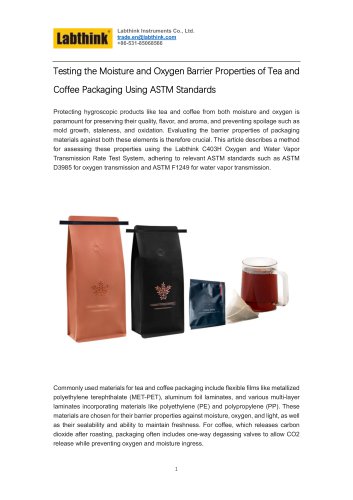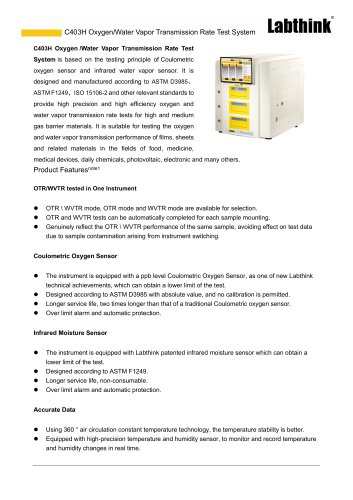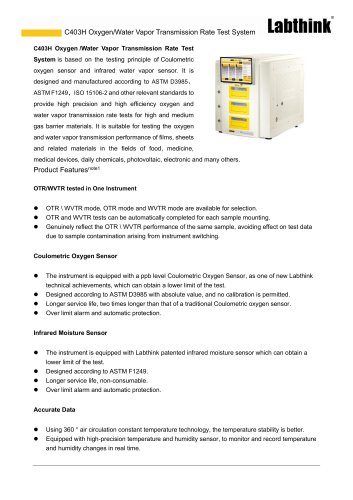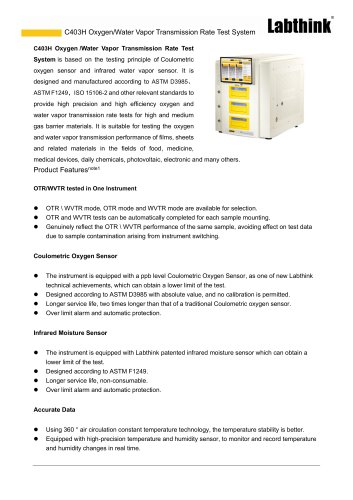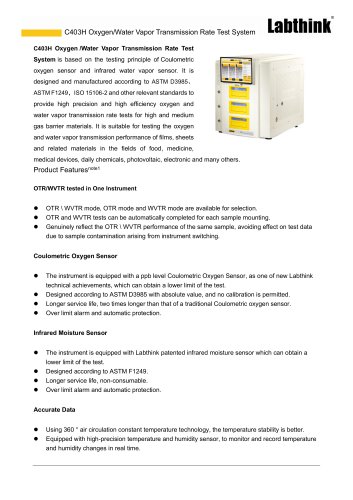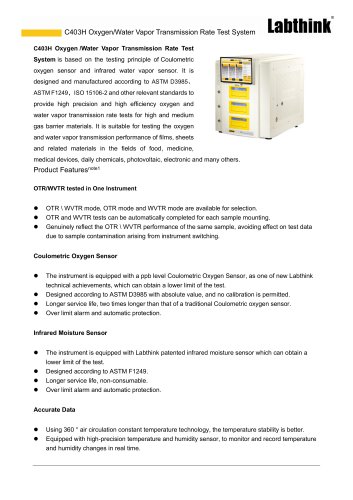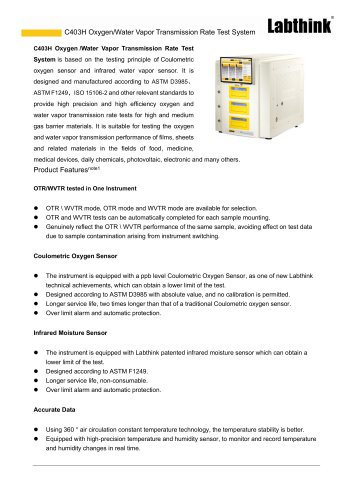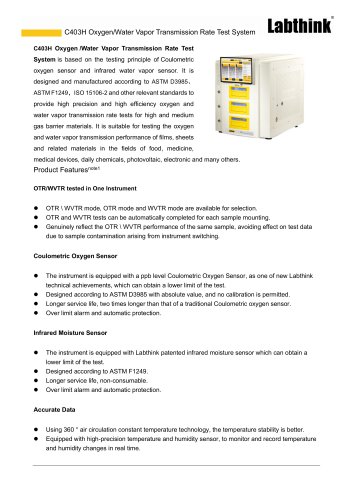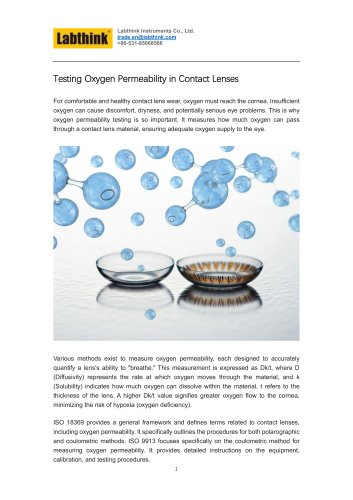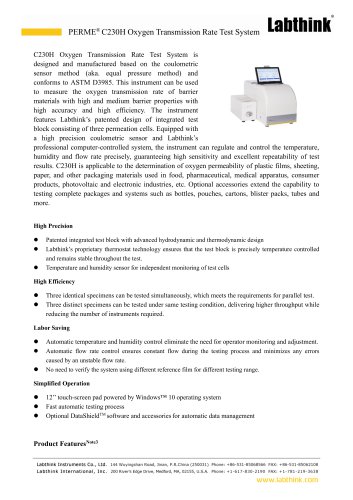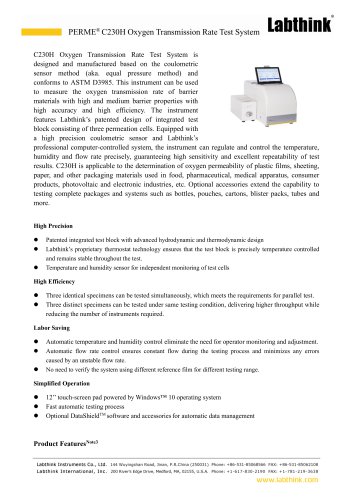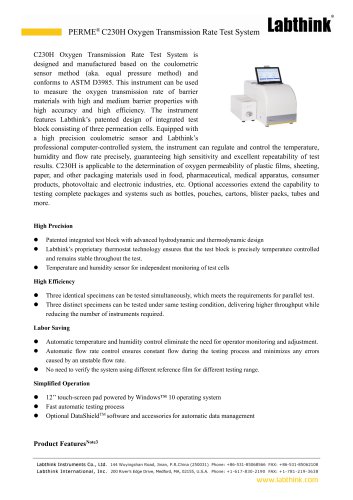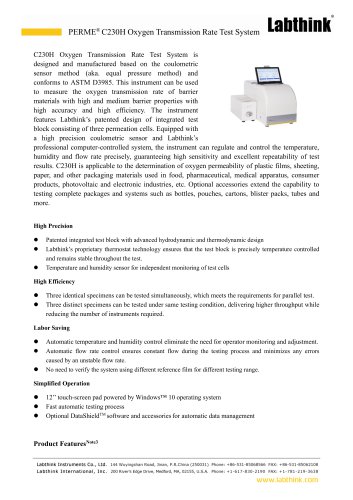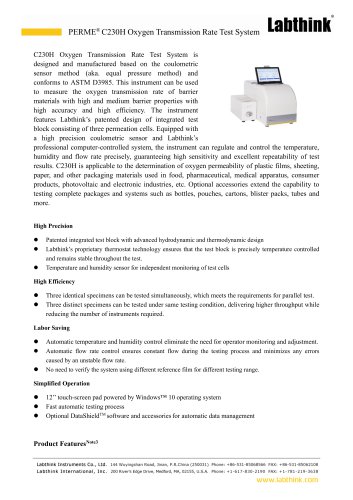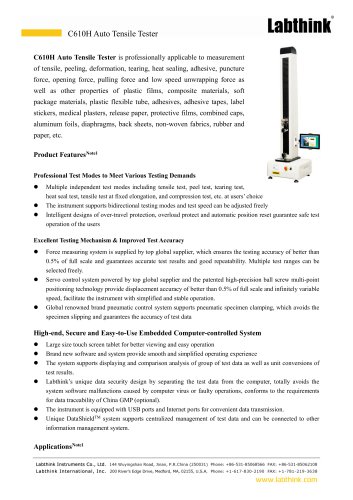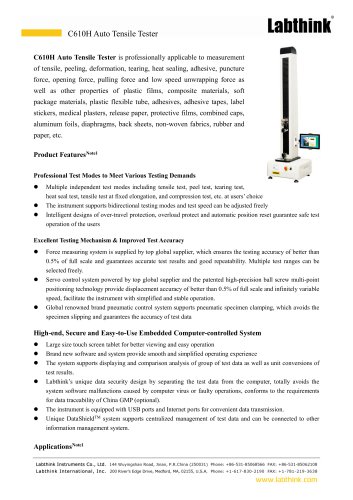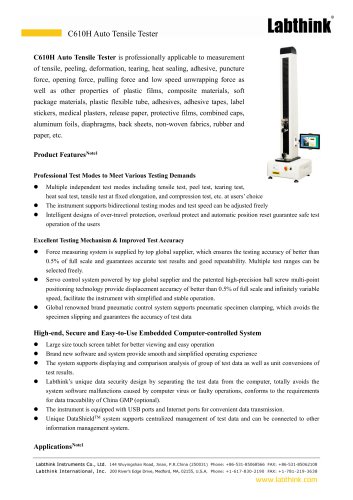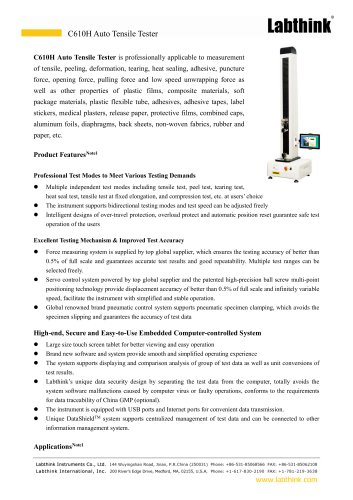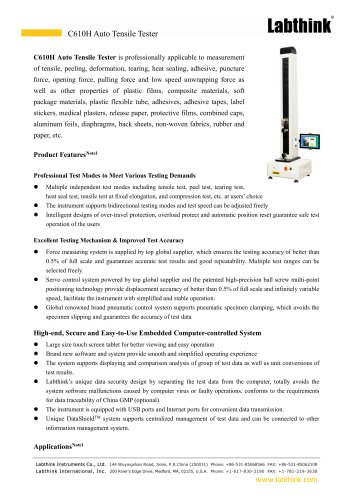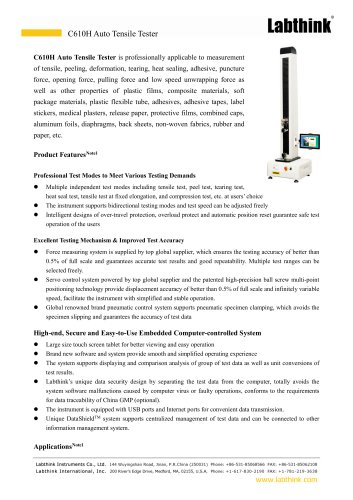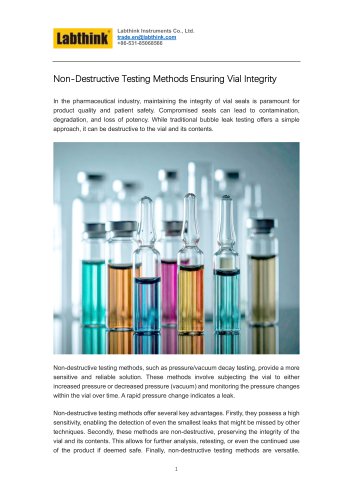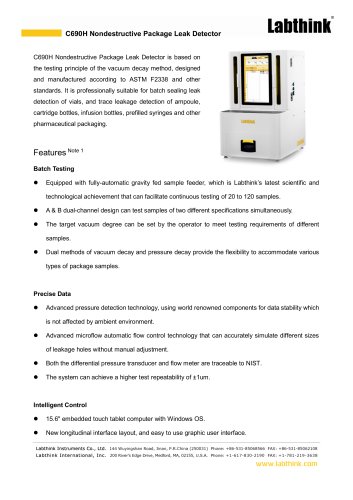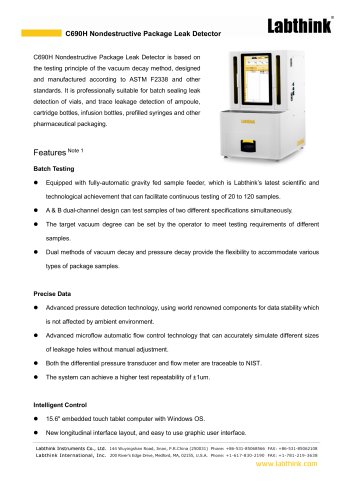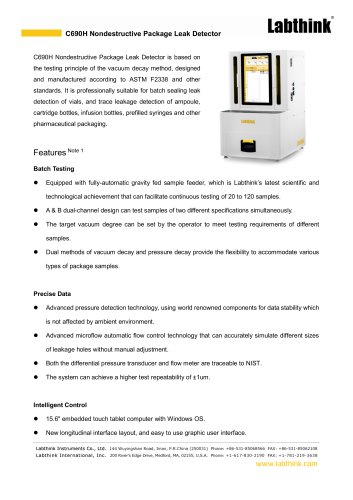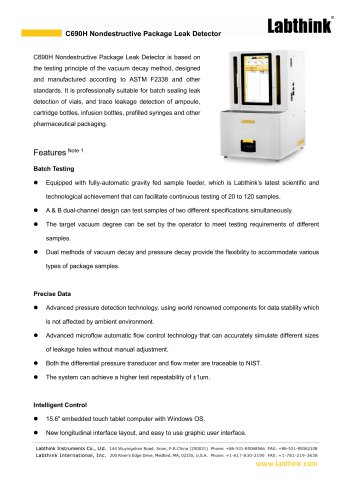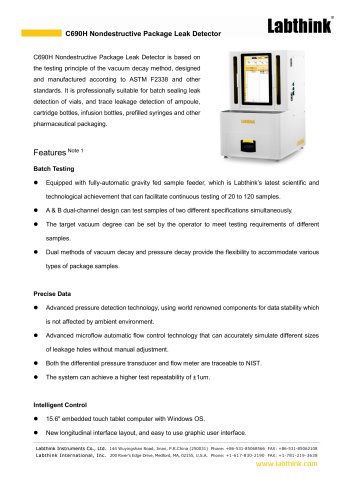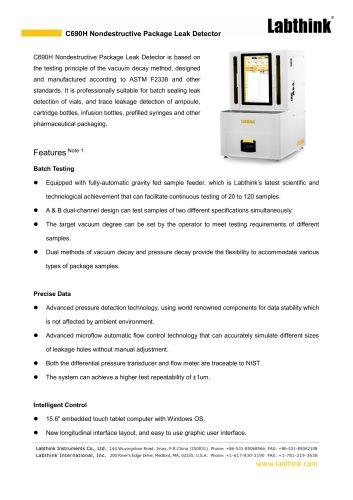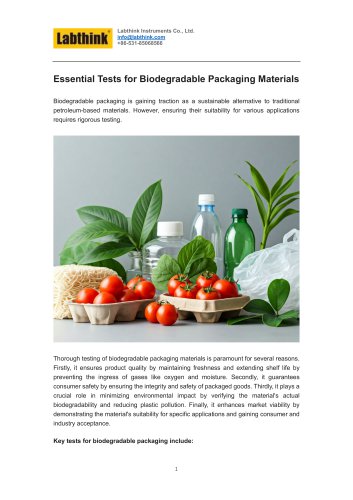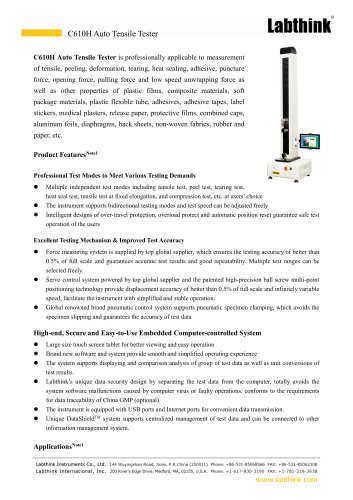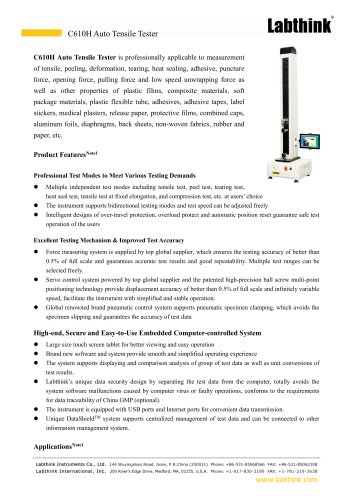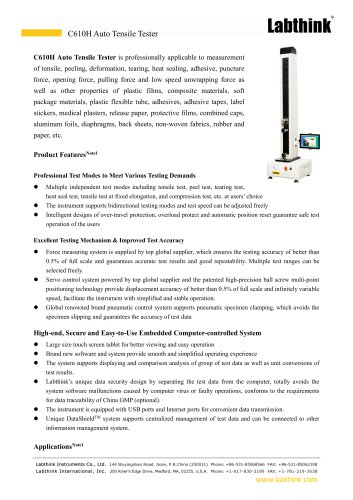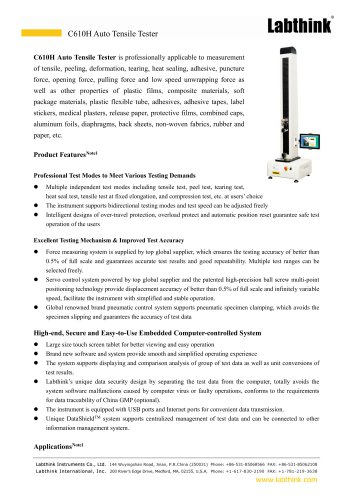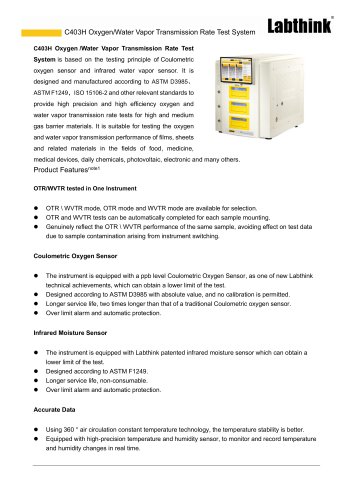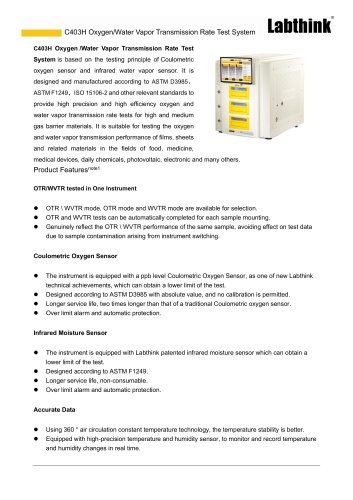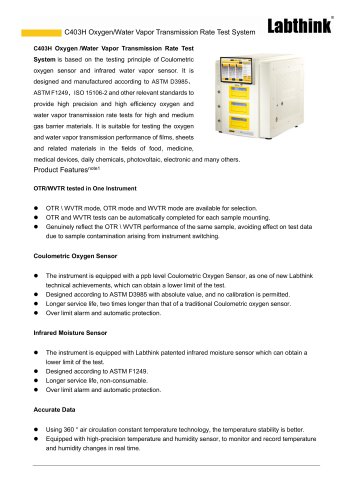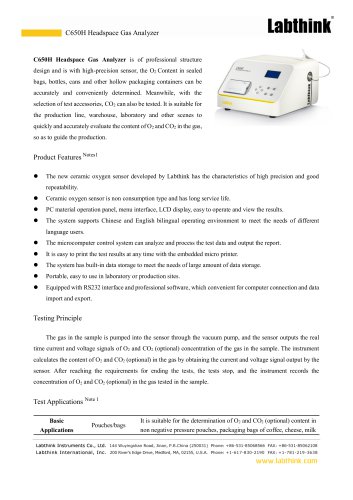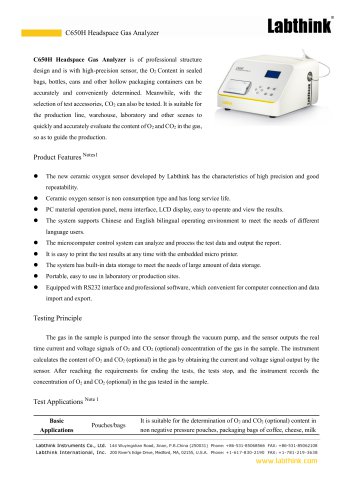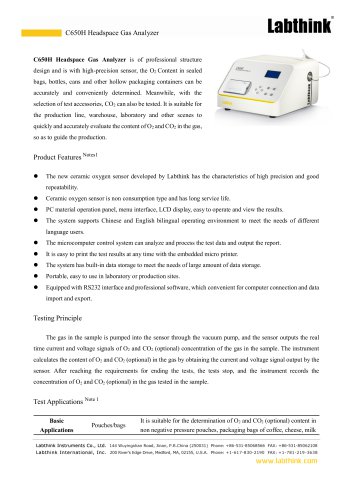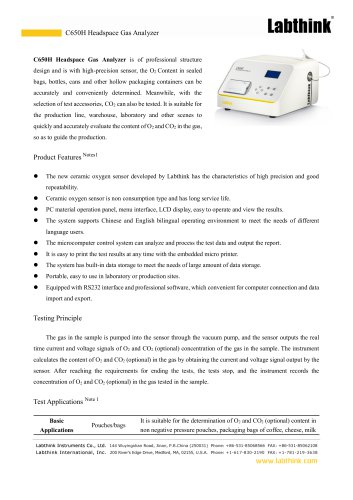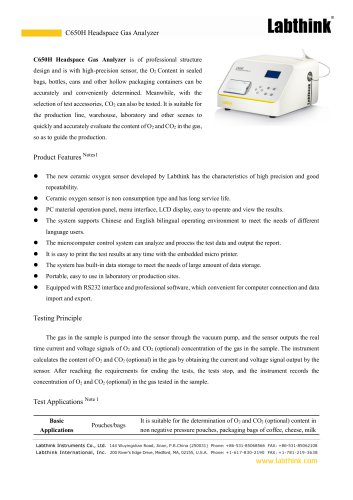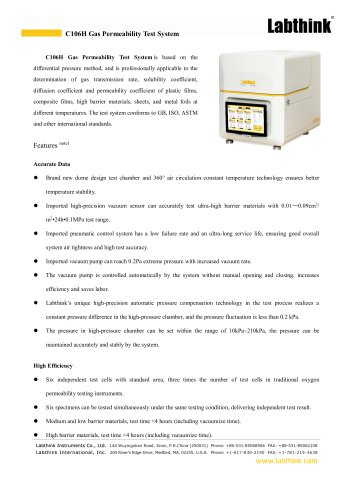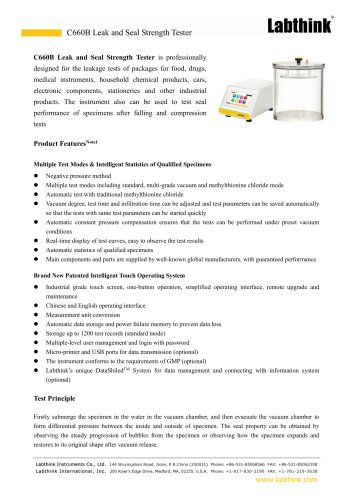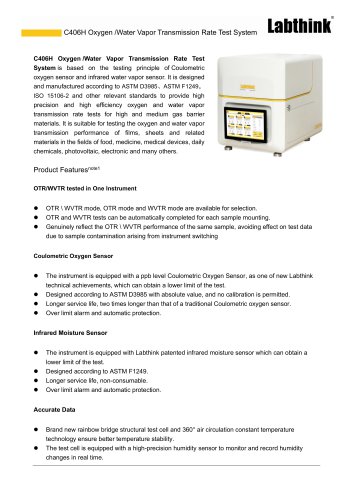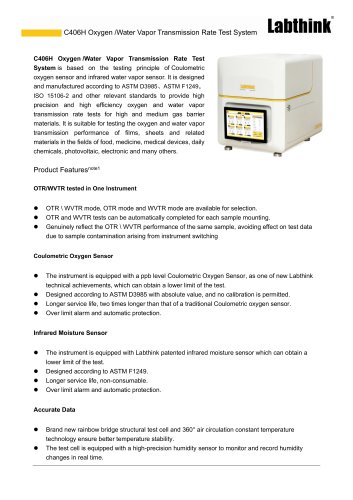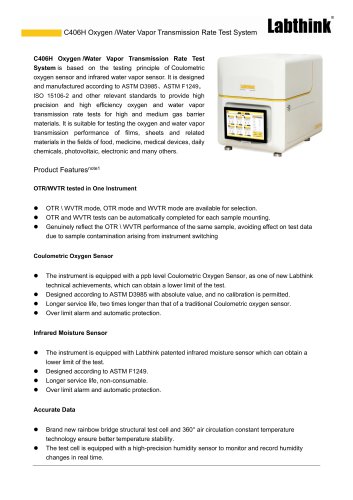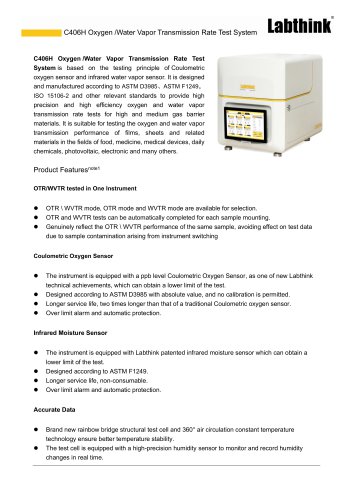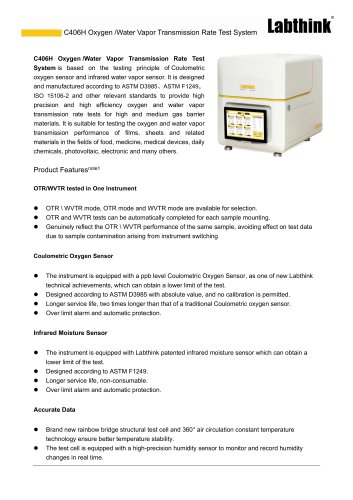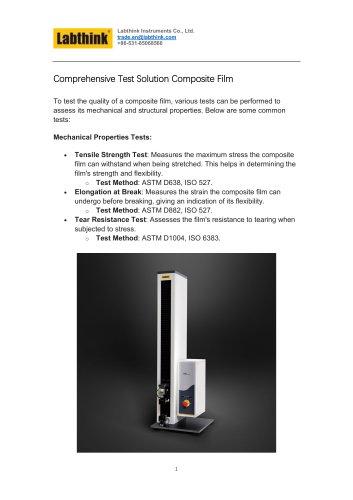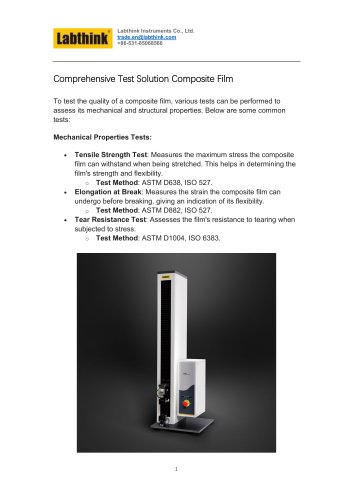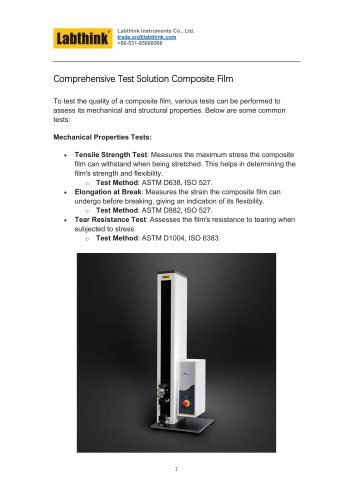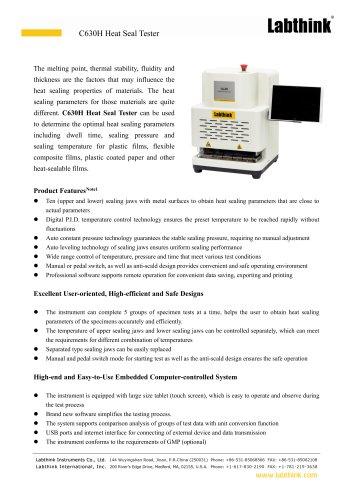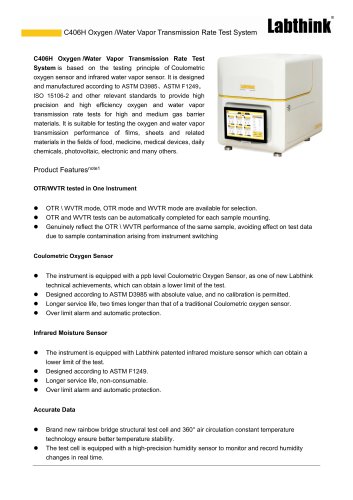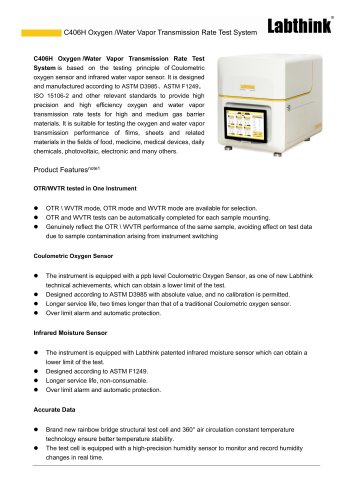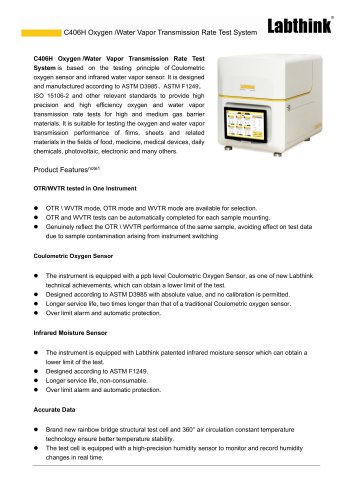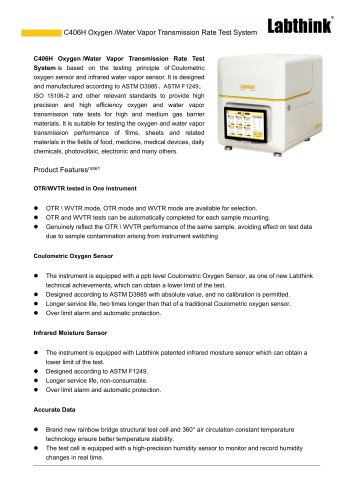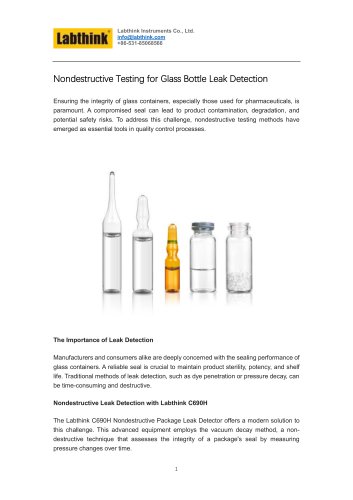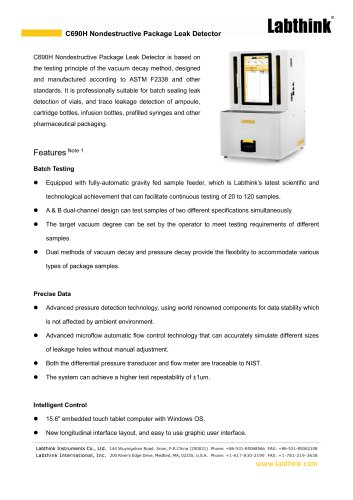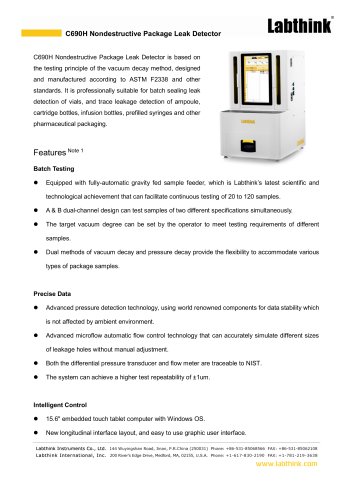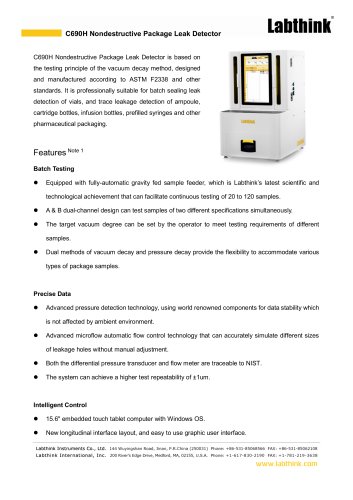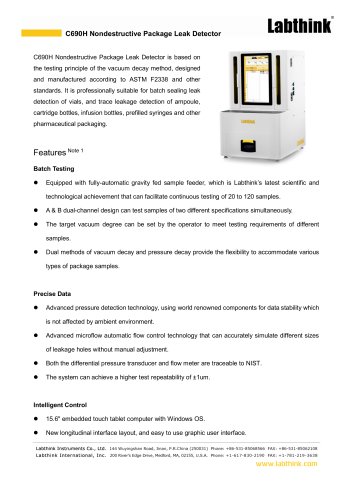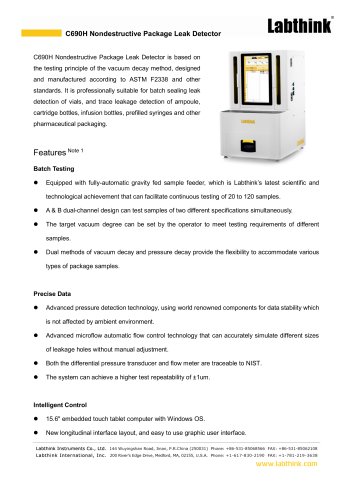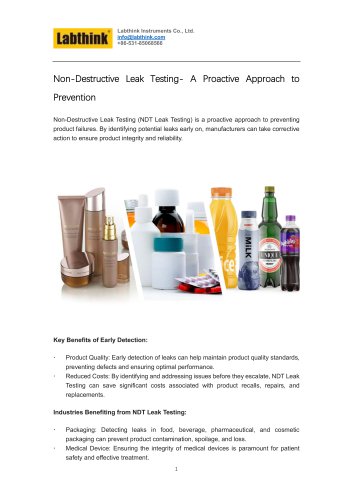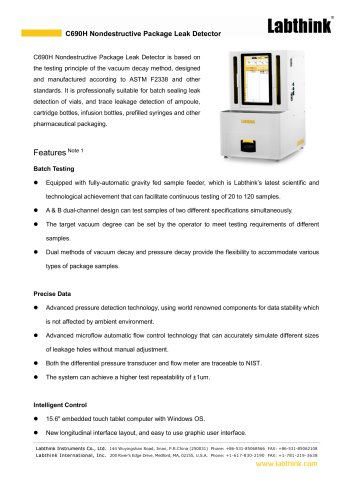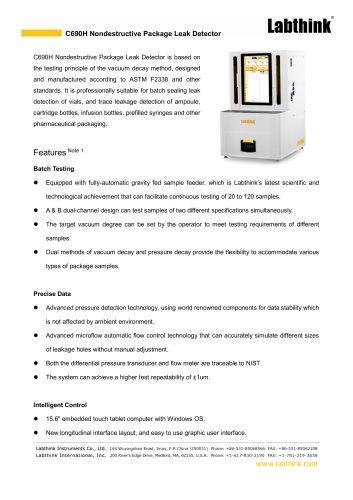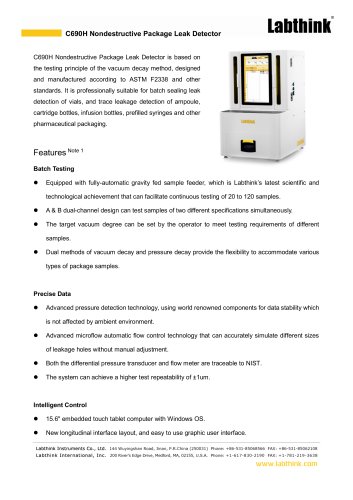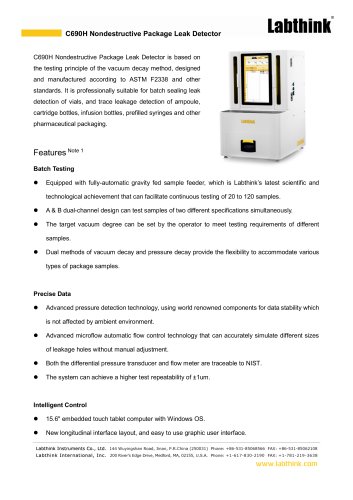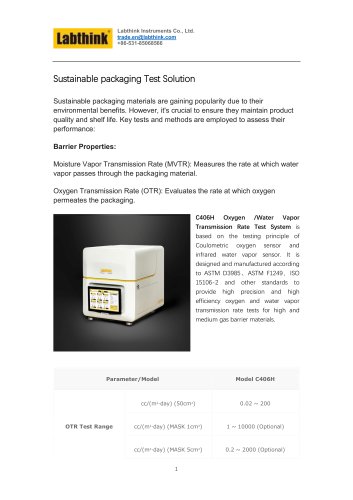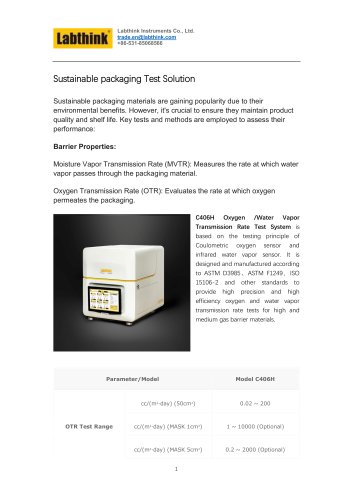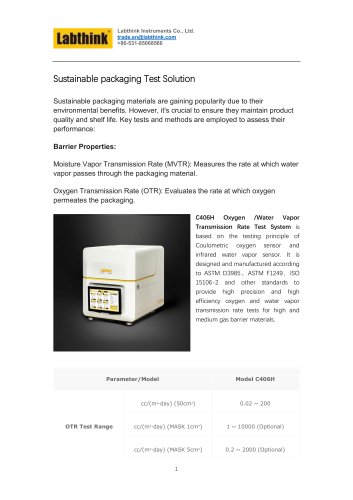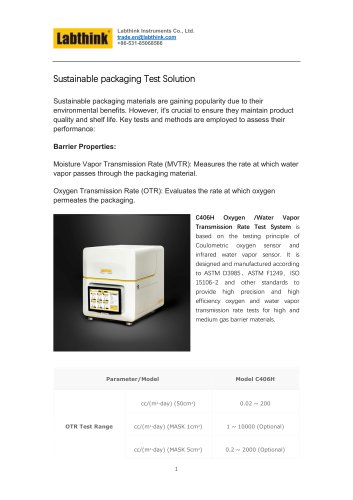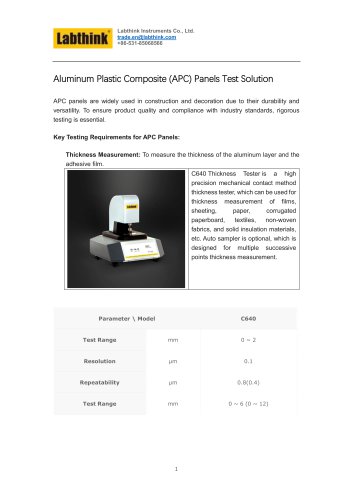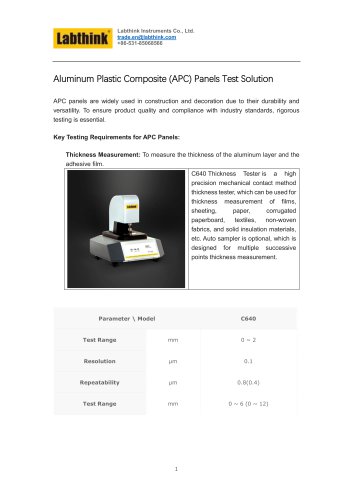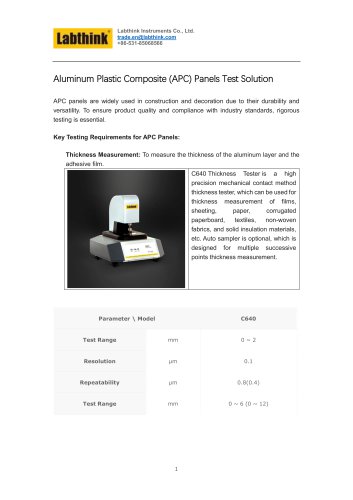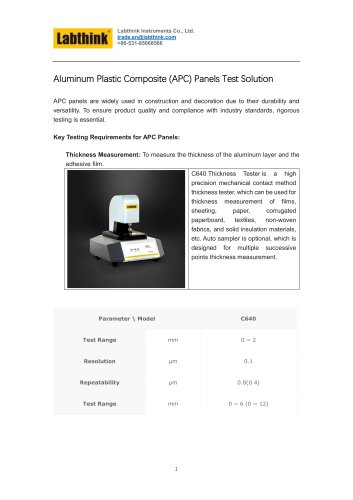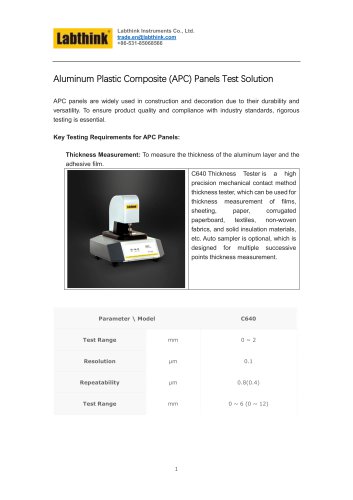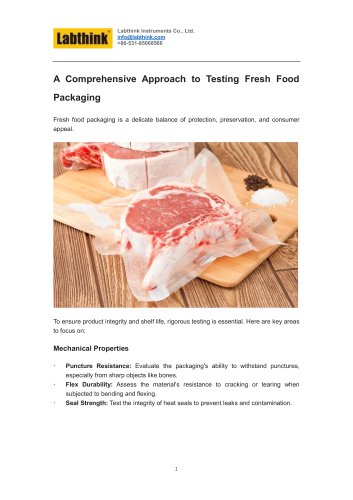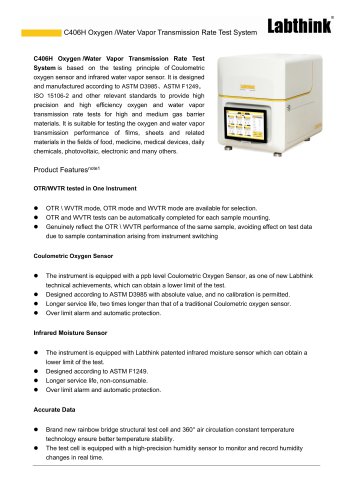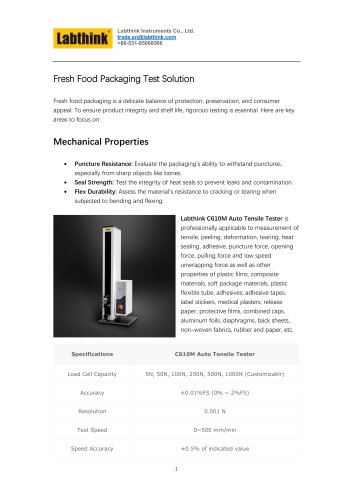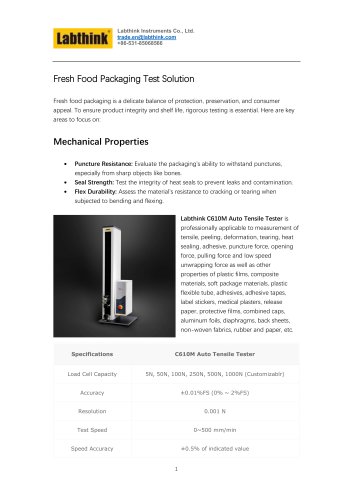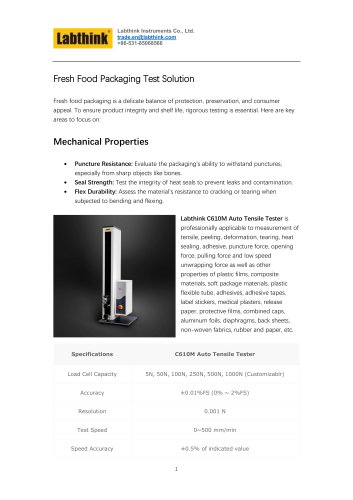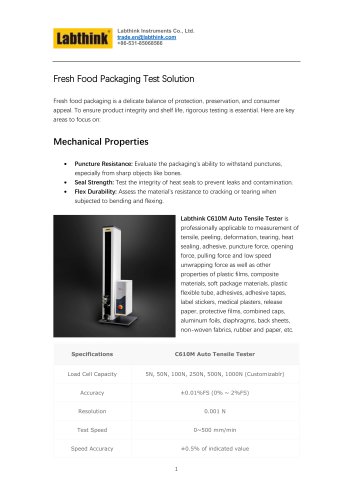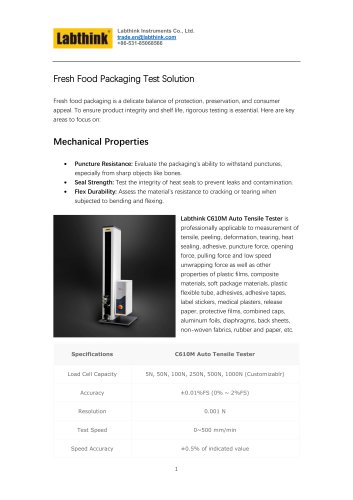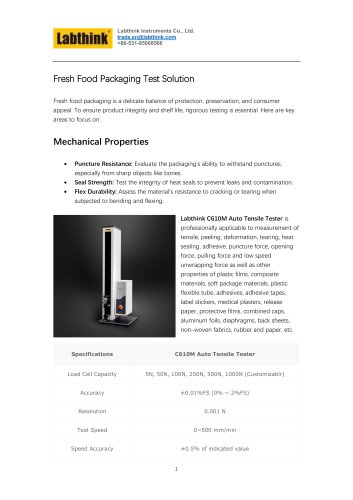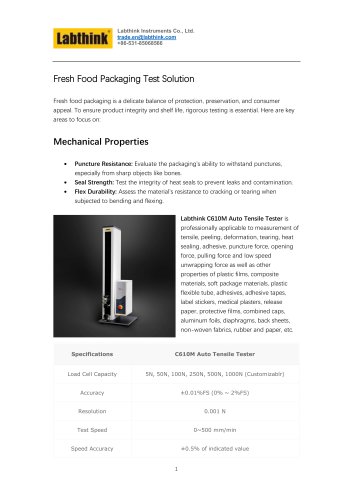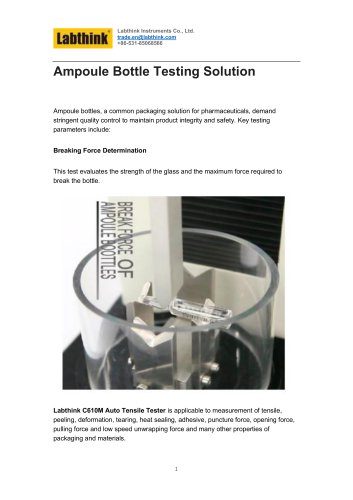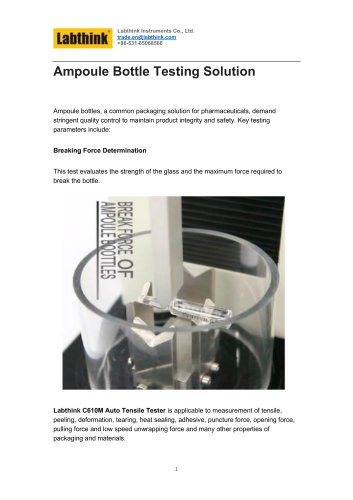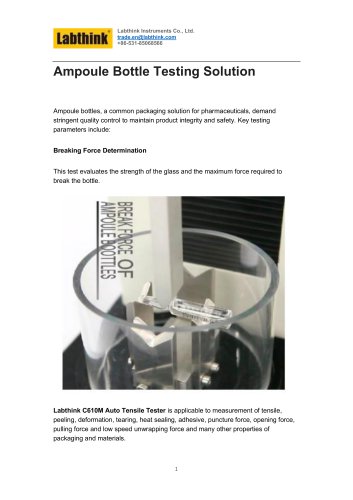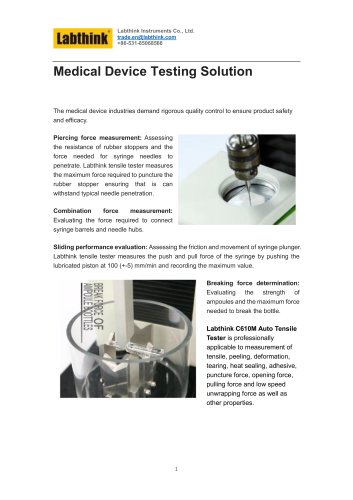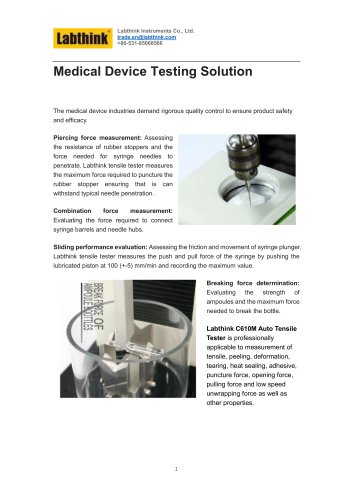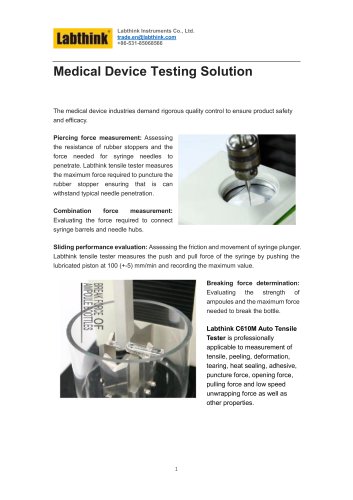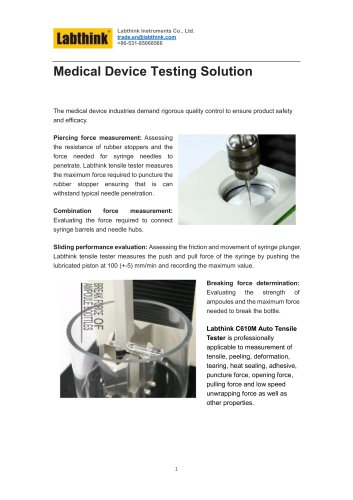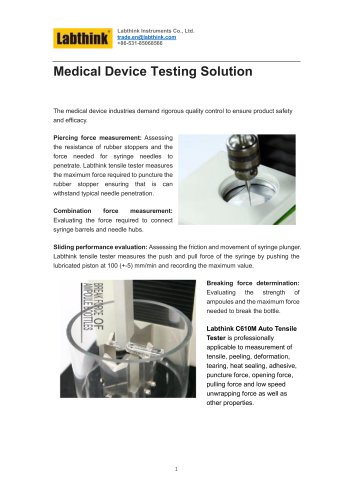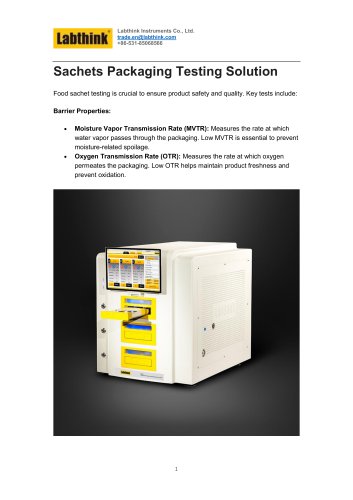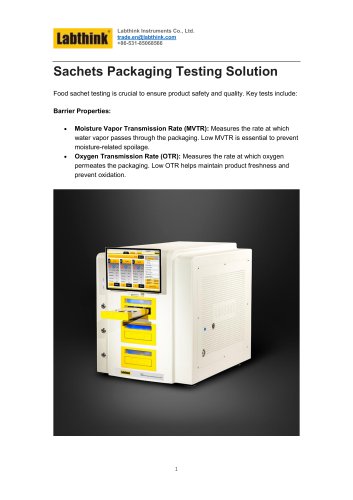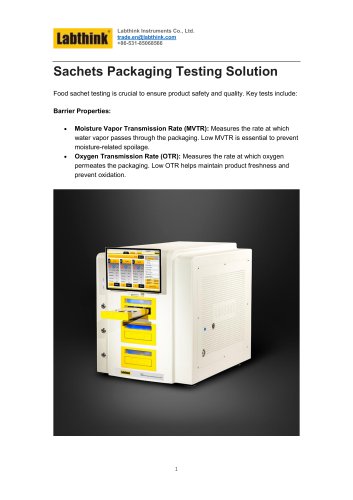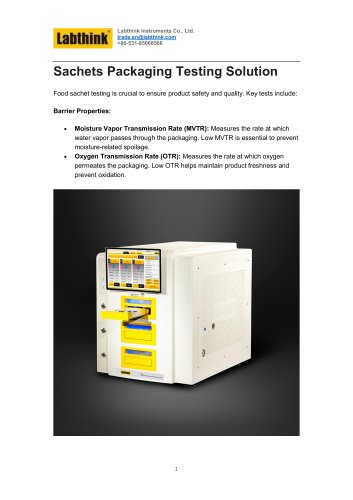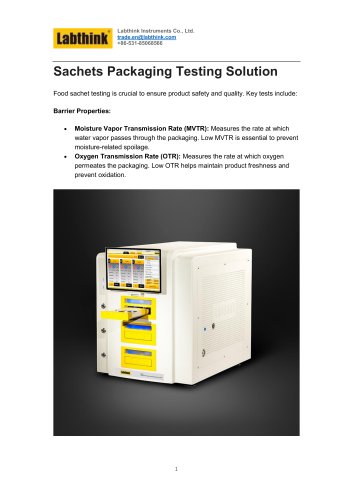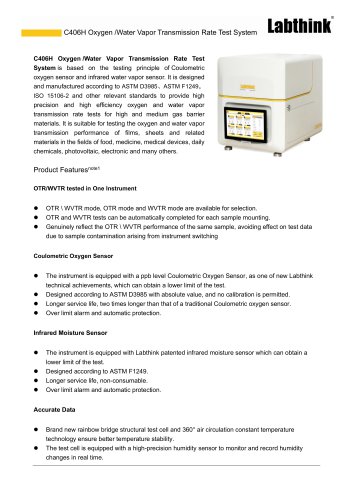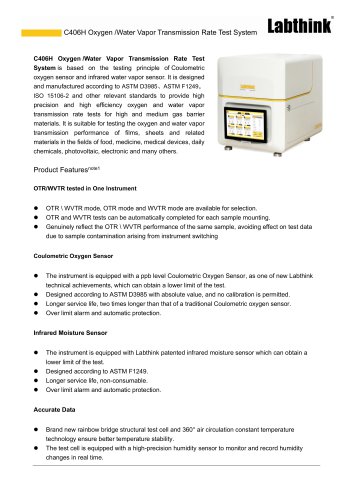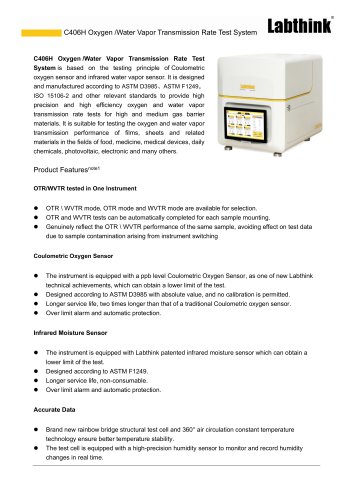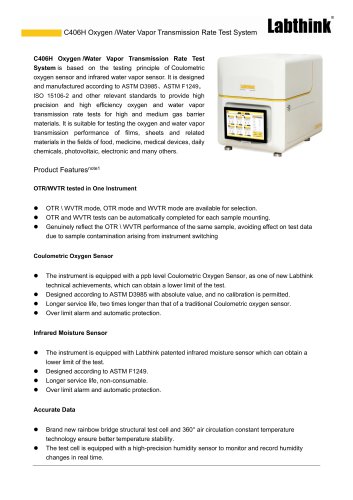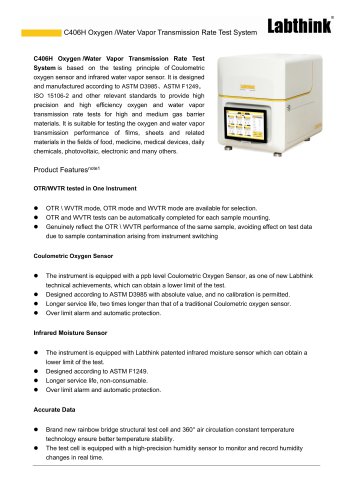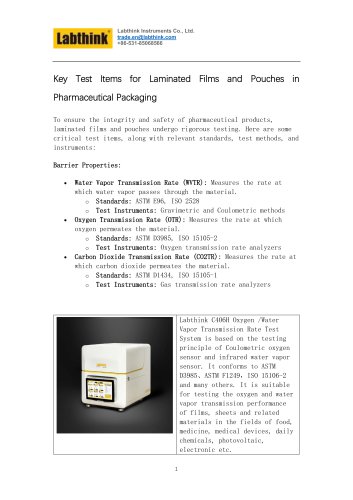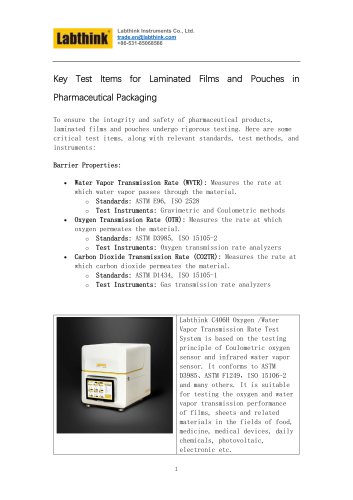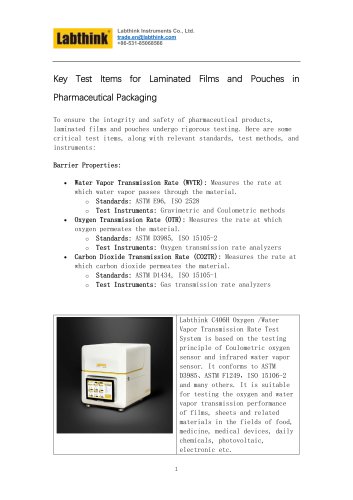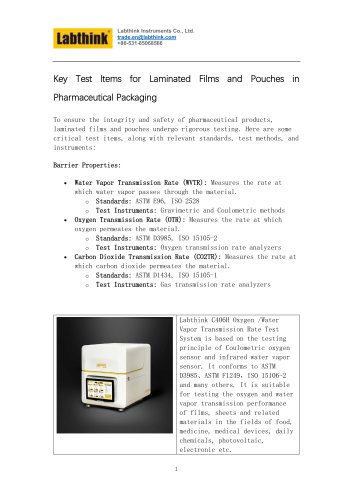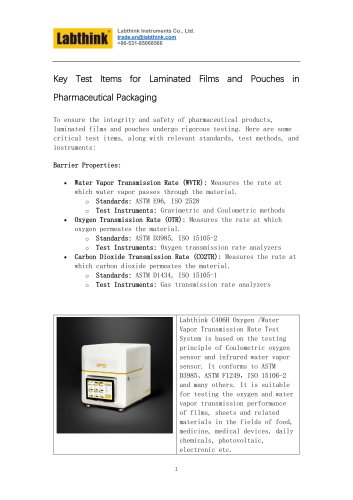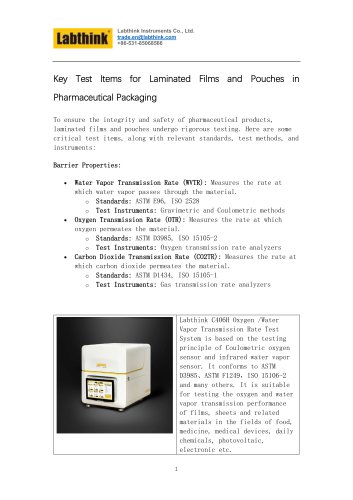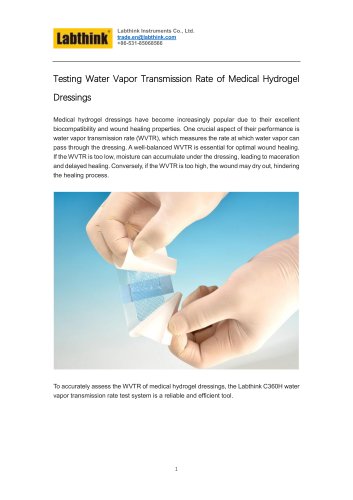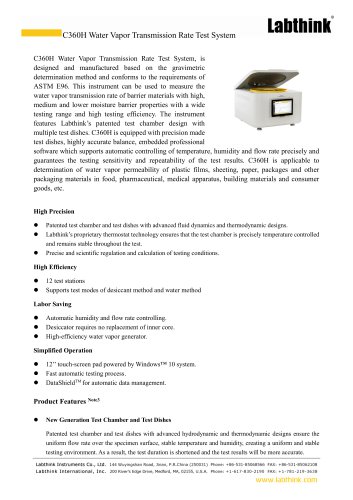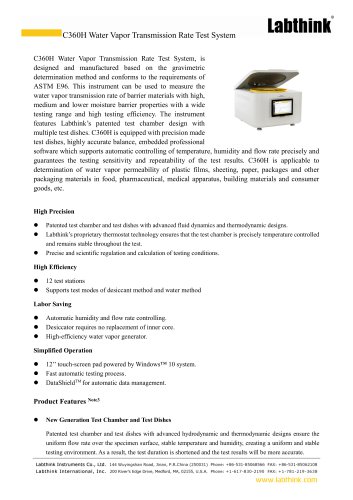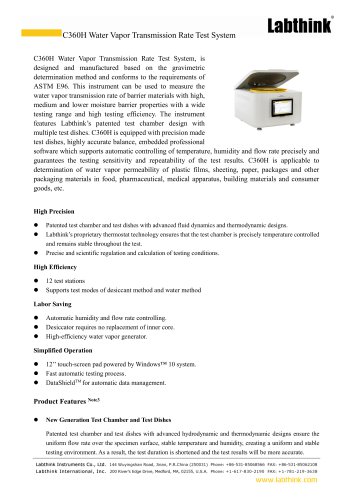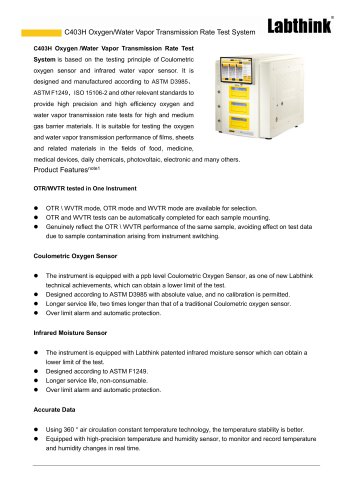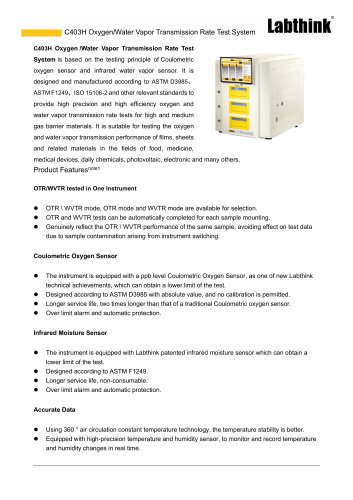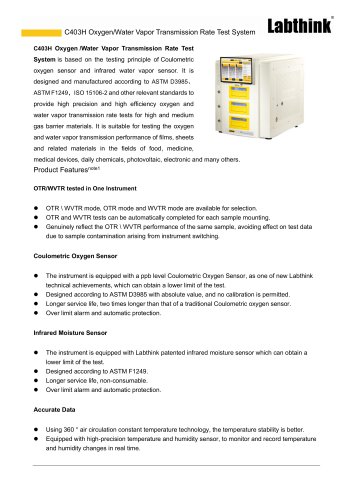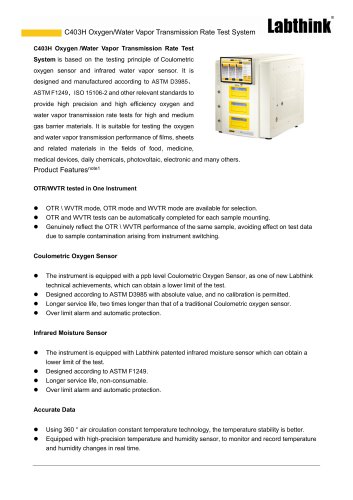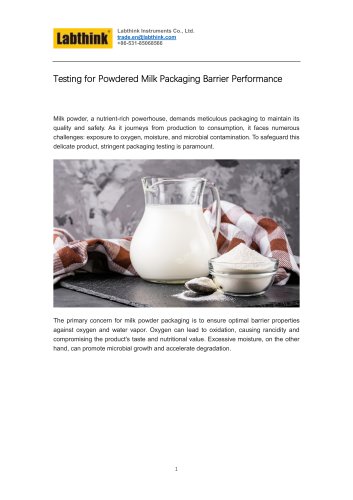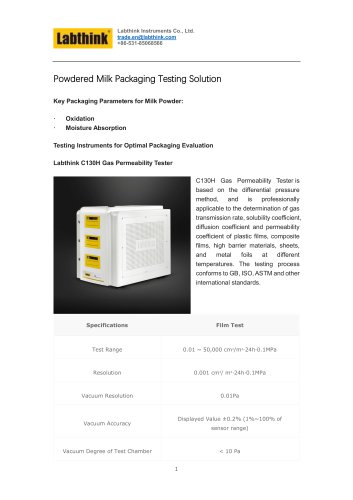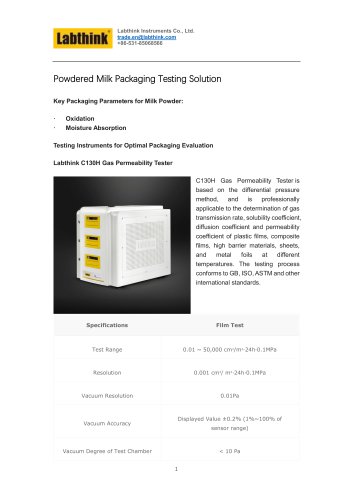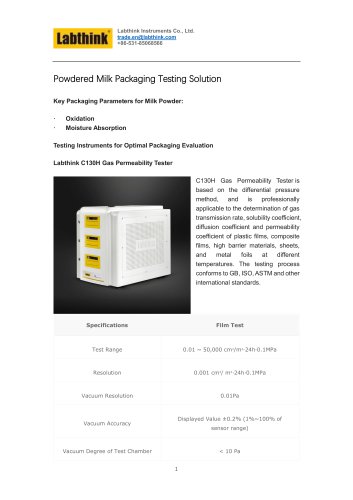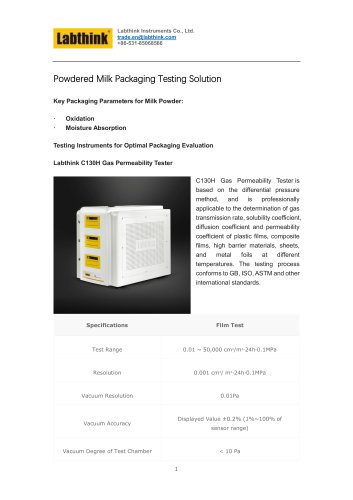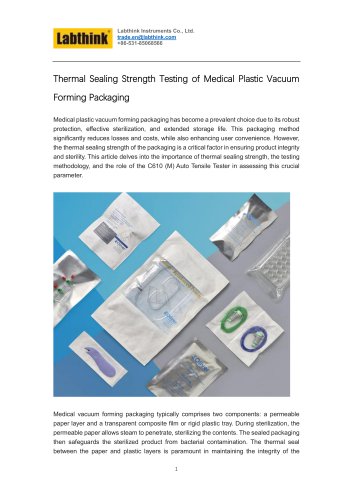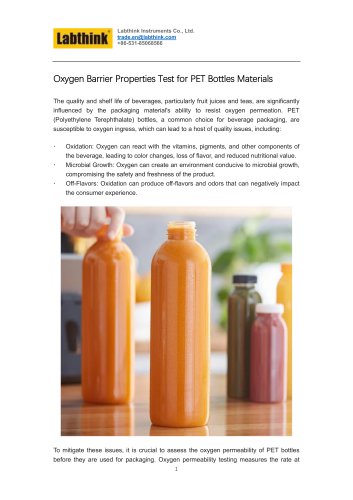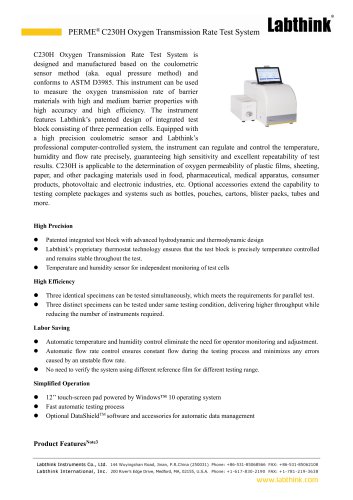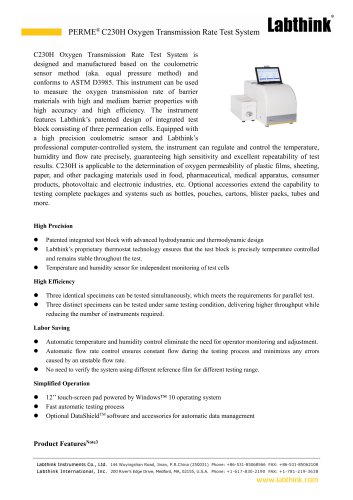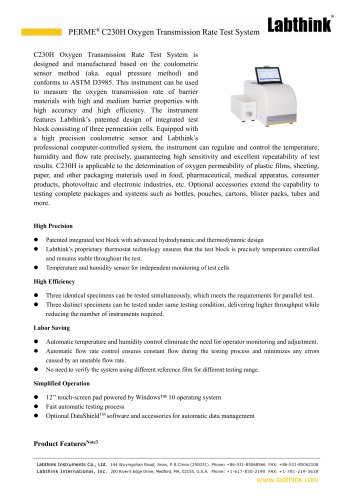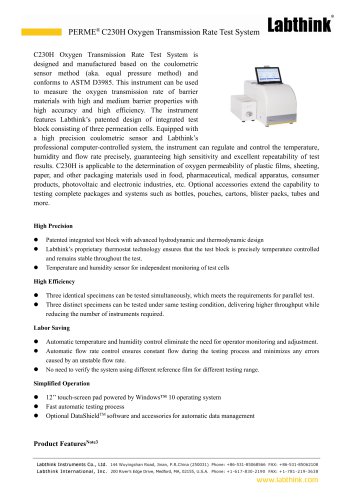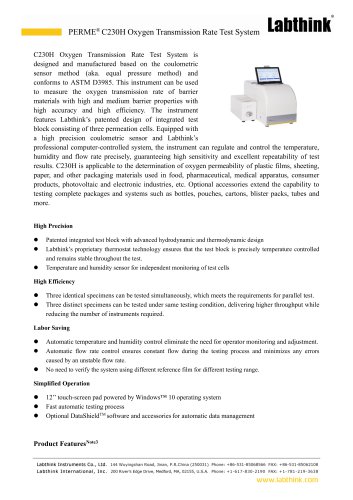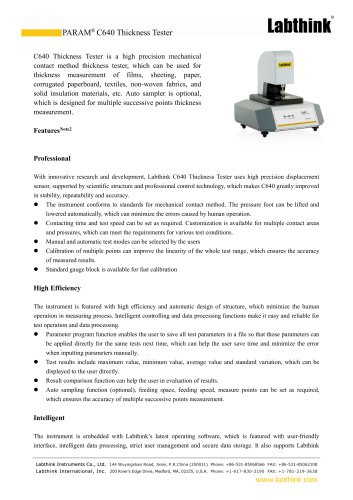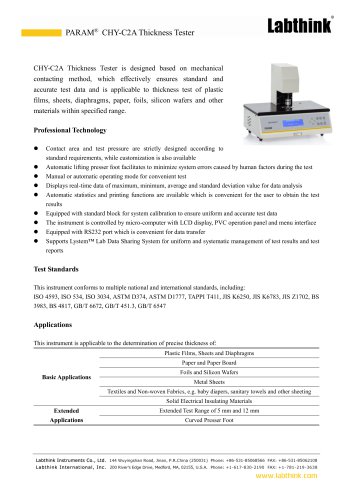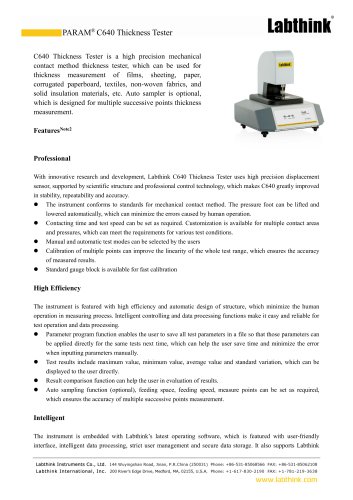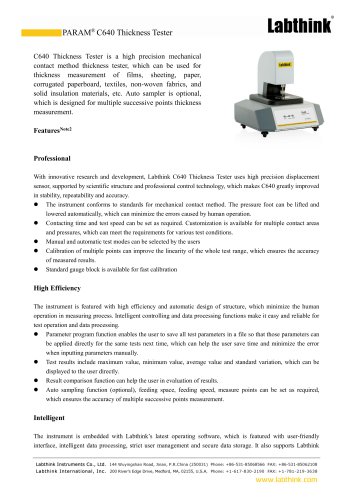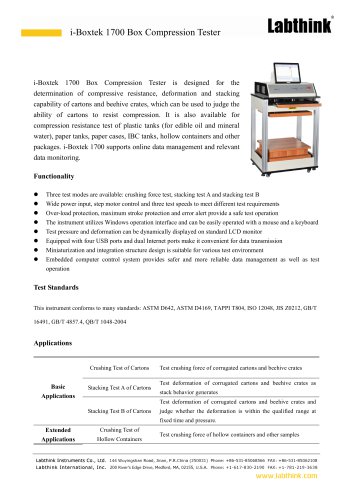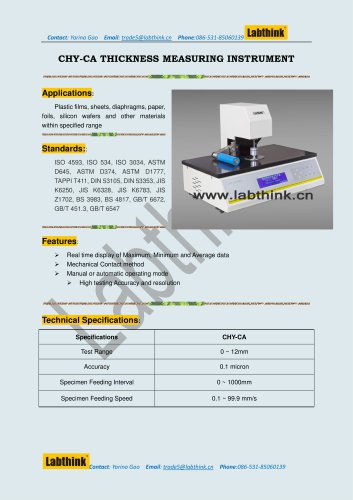 Website:
Labthink Instruments Co., Ltd.
Website:
Labthink Instruments Co., Ltd.
Group: Labthink
Catalog excerpts

Property Concerns of Lithium Ion Battery Separators Business Challenge Lithium-ion batteries have one of the best energy-to-weight ratios, no memory effect, and a slow loss of charge when not in use. This makes them one of the most popular types of batteries for portable consumer electronics in today’s marketplace. Lithium-ion batteries can be found in cameras, laptops, power tools, toys and more. However, as recent well-publicized recalls demonstrate, they can pose a risk of fire and overheating. In addition, they can suffer from a reduced lifespan if not properly treated. As a result, new and stricter requirements are being implemented globally to address potential hazards, leaving manufacturers and purchasers of products containing lithium-ion batteries to meet increasing requirements and overcome safety concerns. Lithium Ion Battery Separators A Lithium Ion battery Separator is a permeable membrane placed between the anode and cathode of a l-ion battery. The main function of a separator is to keep the positive and negative electrodes, the cathode and anode respectively, apart to prevent electrical short circuits while also allowing the transport of ionic charge carriers which are needed to complete the circuit during the passage of current in an electrochemical cell. As mentioned above, separators are power-driven spacers. They can be produced with fiberglass cloth or flexible plastic films made from nylon, polyethylene or polypropylene. It must be absorbent and slim to allow the charged lithium ions to pass without obstruction and it should take up the minimum of space allowed, leaving available space for the cathode active elements. The separators must be able to withstand penetration and branching moss-like crystalline minerals in order to prevent the electrodes from contamination. If the separator breaks down or is infiltrated, this will weaken high power cells end results. Properties of Lithium Ion Battery Separators Chemical Stability Thickness of Separator Porosity of Separator www.labthink.cn/en
Open the catalog to page 1
Pore Size Permeability Mechanical Strength Wet ability Stability Thermal Capabilities Thickness of Separator A battery separator must be relatively thin in order to facilitate the high energy and power densities of the battery. However, if the separator is too thin, it can decrease the mechanical strength and safety of the battery. Additionally, a separator should have uniform thickness in order to support the long like cycle of a battery. In current technologies, 25.4μm is generally accepted as the standard width. The thickness of a polymer separator can be measured using the T411 om-83...
Open the catalog to page 2
Solutions In order to ensure the properties of Lithium Ion Battery separators, some related tests are becoming necessary. Labthink instruments Co., Ltd is the only manufacturer of testing equipment professionally for thin film filed. Everything equipment they have is strictly applying to international standards and considered the manufacturers and users benefits of batteries Thickness Measurement A Gauge used to measure a separator thickness must be with high precision and resolution. Labthink Thickness Tester is professional designed for thin film and paper, with 0 ~ 2mm test range and 0.1...
Open the catalog to page 3All Labthink Instruments Co. catalogs and technical brochures
-
C630H Heat Seal Tester
3 Pages
-
C610M Auto Tensile Tester
3 Pages
-
Heat seal testing instrument
3 Pages
-
Paper Board Thickness Tester
4 Pages
-
Film Thickness Meter
4 Pages
-
C632B Hot Tack Tester
3 Pages
-
C632M Hot tack Tester
3 Pages
-
Tensile Testing Device
3 Pages
-
Peel Force Tester
3 Pages
-
C630H Heat Seal Tester
3 Pages
-
"ELEMENDORF" test device
2 Pages
-
C680M Tearing Tester
2 Pages
-
C650H Headspace Gas Analyzer
2 Pages
-
Box Compression Tester
2 Pages
-
Peel Force Tester
3 Pages
-
Pull Off Adhesion Tester
3 Pages
-
Torque Measuring Devices
3 Pages
-
Bottle Torque Tester
3 Pages
-
Packaging Burst Tester
3 Pages
-
PARAM C640 Thickness Tester
4 Pages
-
Torque Strength Measuring
3 Pages
-
Bottle Leak Tester Machine
3 Pages
-
Oxygen Transmission Tester
4 Pages
-
C612M Digital Torque Tester
3 Pages
-
Bag COF Tester
3 Pages
-
Labthink Headspace Analyzer
2 Pages
-
Sandwich Bag COF Tester
2 Pages
-
Textile Thickness Gauge
4 Pages
-
C680M Tearing Tester
2 Pages
-
C632B Hot Tack Tester
3 Pages
-
Labthink Headspace Analyzer
2 Pages
-
Heat Shrink Tester
2 Pages
-
Tensile Testing Device
3 Pages
-
MAP Packaging Burst Tester
3 Pages
-
MAP Packaging Leak Tester
3 Pages
-
Lug Cap Torque Tester
3 Pages
-
Motorized Pull Test Machine
3 Pages
-
CHY-C2A Thickness Tester
2 Pages
-
Heat Seal Tester
3 Pages
-
Roll Tack Tester
1 Pages
-
Spot Thickness Measurement
4 Pages
-
Adhesive Tack Tester
2 Pages
-
Vacuum Bag Leak Tester
3 Pages
-
Micron Film Thickness Gauge
4 Pages
-
Spot thickness measurement
4 Pages
-
Automatic Tube Leak Tester
2 Pages
-
Burst Test Equipment
3 Pages
-
Elongation Tester
3 Pages
-
Box Compression Test Machine
2 Pages
-
Adhesion Tester for Sticker
2 Pages
-
Ink Rub Lab Equipment
2 Pages
-
Friction Testing Machine
3 Pages
-
Fabric Thickness Measurement
4 Pages
-
Snack Bag Leak Detector
3 Pages
-
Carton Stacking Test Machine
2 Pages
-
Sheet Metal Thickness Gauge
4 Pages
-
Residual oxygen level tester
2 Pages
-
Vacuum Tube Leak Tester
3 Pages
-
leak detector for packaging
3 Pages
-
bottle torque tester machine
3 Pages
-
micrometer per ASTM D374
4 Pages
-
rub tester for wine labels
2 Pages
-
LAB THICNESS TESTER
3 Pages
-
Peel tester for 180 Degree
5 Pages
-
Ball tack tester
5 Pages
-
table top thickness gauge
12 Pages
-
Tabletop sealing machine
14 Pages
-
Film Friction Tester
2 Pages
-
Head space Oxygen Analyser
2 Pages
-
90 degree peel test Device
3 Pages
-
C681M Flex Durability Tester
2 Pages
-
C650M Headspace Gas Analyzer
2 Pages
-
C650B Headspace Gas Analyzer
2 Pages
-
C632B Hot Tack Tester
3 Pages
-
C630H Heat Seal Tester
3 Pages
-
C620H Friction
3 Pages
-
C611M Box Compression Tester
2 Pages
-
C611B Box Compression Tester
2 Pages
-
C610M Auto Tensile Tester
3 Pages
-
C610H Auto Tensile Tester
3 Pages
-
Handheld Headspace Analyzer
2 Pages
-
Cap Torque Machine
5 Pages
-
Oxygen Permeation Analyser
3 Pages
-
Oxygen Permeation Apparatus
3 Pages
-
Papier Abrieb-Testmaschine
1 Pages
-
Bottle Cap Leak Tester
4 Pages
-
torque meter for PET Bottles
3 Pages
-
box compression device
5 Pages
-
BLJ-02 Disk Stripping Tester
2 Pages
-
RT-01 Rub Tester
2 Pages
-
MCJ-01A Rub Tester
2 Pages
-
Floor Slip Resistance Tester
5 Pages
-
Leak Tester
3 Pages
-
Consultative Testing Service
4 Pages
-
BOPP Tape Shear Tester
3 Pages
-
Bell Jar leak tester
2 Pages
-
COF testing of Polymer Films
2 Pages
-
labthink MFY-01 Leak Tester
3 Pages
-
Heat Sealing Property Tester
1 Pages
-
Tablet Leak Test Apparatus
5 Pages
-
Precise Tape Peeling Tester
5 Pages
-
BOPP Film Thickness Meter
2 Pages
-
Package Headspace Analyzer
5 Pages
-
electrical torque meter
5 Pages
-
tape peeling tester
5 Pages
-
tensile testing instrument
5 Pages
-
gas leakage detector LSSD-01
5 Pages
-
XLW (G6) Auto Tensile Tester
3 Pages
-
XLW (M) Auto Tensile Tester
3 Pages
-
XLW (B) Auto Tensile Tester
2 Pages
-
XLW Auto Tensile Tester
3 Pages
-
CHY-C2 Thickness Tester
2 Pages
-
CHY-CA Thickness Tester
2 Pages
-
XLW (PC) Auto Tensile Tester
3 Pages
-
Plastic Film Thickness Test
2 Pages
-
Tensile Strength Machine
5 Pages
-
fogging testing machine
5 Pages
-
heat sealing testing machine
5 Pages
-
shrinkage testing machine
5 Pages
-
torque testing machine
5 Pages
-
Medical Package leak Tester
5 Pages
-
Food Package leak Tester
5 Pages
-
ink rubbing test machine
5 Pages
-
rolling ball tack tester
5 Pages
-
Glebo flex tester
5 Pages
-
hot tack tester
5 Pages
-
tape peel force tester
5 Pages
-
Rolling Ball Tester
5 Pages
-
permeability apparatus
5 Pages
-
CHY-CB Thickness Tester
2 Pages
-
Heat Shrinkage Force Tester
5 Pages
-
XLW (EC) Auto Tensile Tester
3 Pages
-
gas leakage detector MFY-01
5 Pages
-
materials Flex tester
5 Pages
-
oxygen headspace analyzer
5 Pages
-
cap torque testing machine
5 Pages
-
Lasting Ahesion Tester
5 Pages
-
Peeling strength tester
5 Pages
-
Torque Measurement Equipment
2 Pages
-
Heat Sealing Test machine
1 Pages
-
FDI-01
5 Pages
-
Leakage Detector
5 Pages
-
Rolling Ball Adhesion Tester
1 Pages
-
film thickness gauge
5 Pages
-
rub testing machine
5 Pages
-
air leakage tester
5 Pages
-
vacuum leak detector
4 Pages
-
plastic film testing machine
3 Pages
-
carton compression test
5 Pages
-
plastic cap torque tester
5 Pages
-
manual torque tester
1 Pages
-
opening torque tester
2 Pages
-
Oxygen headspace Analyzer
2 Pages
-
Permeability Test System
2 Pages
-
DIN 75201
2 Pages
-
Tensile strength test bench
5 Pages
-
impact testing equipments
2 Pages
-
thickness gauge
5 Pages
-
vacuum leak testing machine
2 Pages
-
paper thickness measurement
5 Pages
-
FDT-02 Gelbo Flex Tester
5 Pages
-
Friction Coefficient Tester
5 Pages
-
Drop Ball Impact Tester
5 Pages
-
Dealers wanted
1 Pages
-
Abrasion Resistance Tester
2 Pages
-
HST-H3 Heat Sealing Machine
1 Pages
-
FPT-F1 Friction/ Peel Tester
2 Pages
-
FT-F1 Fogging Tester
2 Pages
-
Material Testing Equipment
2 Pages
-
Packaging Testing
2 Pages
-
Abrasion Test
2 Pages
-
Torque Meter
2 Pages
-
pendulum impact tester
2 Pages
-
Oxygen Transmission Analyzer
2 Pages
-
Friction Tester
2 Pages
-
Leak Detector
2 Pages
-
Analyzer for MAP
2 Pages
-
Adhesive Strength Tester
1 Pages
-
O2 & CO2 Analyzer
1 Pages
-
Gas Permeability Tester
2 Pages
-
Heat Thermal Shrink Tester
1 Pages
-
Paper Air Resistance Tester
1 Pages
-
Lasting Adhesive Tester
2 Pages
-
Cap Torque Tester
3 Pages
-
Lasting Adhesion Tester
2 Pages
-
Gradient Heat Seal Tester
4 Pages
-
Head space gas Analysis
4 Pages
-
Headspace Gas Analyser
3 Pages
-
Headspace Gas Analyzer
3 Pages
-
Material Tensile Tester
5 Pages
-
Ink Rub Tester
2 Pages
-
medical packaging tester
3 Pages
-
Hot Tack Tester (Data Sheet)
2 Pages
-
Heat Sealing tester
2 Pages
-
Evaporation Residue Tester
3 Pages
-
Blister Package testing
3 Pages
-
Gas Permeability Analyzer
3 Pages
-
Tensile Testing Machine
2 Pages
-
package integrity tester
2 Pages
-
Oxygen permeation Analyzer
2 Pages
-
Drop Impact Tester
2 Pages
-
Torque tester
2 Pages
-
Compression Testing Machine
2 Pages
-
Material Testing Machine
3 Pages
-
Shrink Film testing
2 Pages
-
fogging tester
2 Pages
-
Impact tester
2 Pages
-
Quality Concerns of Doypacks
2 Pages
-
Material Testing
2 Pages
-
laboratory heat sealer
2 Pages
-
Automated Heat Sealer
1 Pages
-
analog thickness gauge
1 Pages
-
Residual Gas Analyzer
1 Pages
-
digital torque gauge
1 Pages
-
packaging Industry
2 Pages
-
Metrology and Test Equipment
2 Pages
-
Tensile Tester
2 Pages
-
material moisture monitor
2 Pages
-
Gas Analyzer
2 Pages
-
Headspace Gas Analyzer
1 Pages
-
FRICTION/PEEL TESTER
1 Pages
-
HOLDING TACK TESTER
1 Pages
-
ROLLING BALL TESTER
1 Pages
-
BOX COMPRESSION TESTER
1 Pages
-
INK RUB TESTER
1 Pages
-
FOGGING TESTER
2 Pages
-
Film Shrinkage Tester
1 Pages
-
Film Pendulum Impact Tester
1 Pages
-
FALLING DART IMPACT TESTER
1 Pages
-
THICKNESS TESTER
1 Pages
-
TOQUE TESTER
1 Pages
-
Tearing Tester
1 Pages
-
Gas Permeability Tester
1 Pages
-
Oxygen Permeability Tester
2 Pages
Archived catalogs
-
Leak Tester
2 Pages


